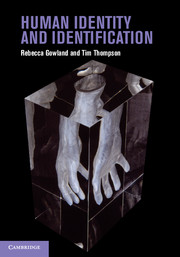6 - Biomolecular identification and identity
Published online by Cambridge University Press: 05 February 2013
Summary
Genes aren’t what they used to be.
(Fortun, 2009: 255)The focus of identity and identification research within the biological and social sciences has traditionally been on macroscopic observations. Technological advances, however, have allowed scientists to investigate the body on a biomolecular scale – the hitherto unknown parts of our physiological make-up – and this in turn has led to a seismic shift in our perceptions of self and others. Naturally, our DNA is likely the first of these microscopic components to spring to mind, but there are others too, including the biochemical composition of our body’s tissues and the microbial communities that colonise them. This chapter discusses a few of these biomolecular features of the body in terms of their significance for human identification and identity. The role of DNA for human identification in forensic and anthropological work has already received much attention; less commonly explored within this sphere however, and which we discuss here, is the dynamic interrelationship between the body on this micro scale and social identity and environment. Our DNA is not as immutable or prescriptive in terms of our phenotype as once thought; for example, gene expression can depend on such intangible factors as perceived social isolation, which in turn can have profound physiological consequences (such as poorer health outcomes). Genetic imprinting, epigenetics and social genomics have become a significant field of study and gone are the previously held certainties concerning DNA as a ‘blueprint for humanity’ (see Atkinson et al., 2009 for a thorough review of the relationship between genetics and society). The concept of the ‘triple helix’ of gene/organism/environment and the complexity of these interactions in shaping bodily processes and responses has been at the forefront of more recent genetic work (Lewontin, 2000). Despite this, genes are still viewed in a largely simplistic and deterministic way by the general public, and also by many working in the field of human identification.
- Type
- Chapter
- Information
- Human Identity and Identification , pp. 132 - 158Publisher: Cambridge University PressPrint publication year: 2013



